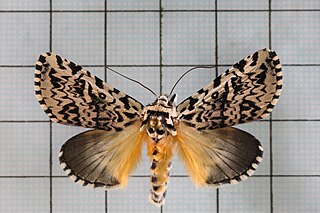
Tagiades, commonly known as snow flats, is a genus of spread-winged skipper butterflies. It is the type genus of the tribe Tagiadini of the subfamily Pyrginae in the family Hesperiidae. It contains seventeen species; three of which are found in tropical Africa, while fourteen are found from India, Sri Lanka, Southeast Asia, northeast Australia, to the Pacific Islands. They are primarily diurnal butterflies, and can usually be found in secondary forests at up to 1,300 m (4,300 ft) above sea level. They can sometimes be encountered in partially cleared or cultivated areas. They are fast flyers, flying at an average height of 2 to 6 m. They usually rest on the undersides of leaves. When disturbed they will fly away but will usually return to the preferred area, often to the same leaf.
The Sri Lanka national rugby union team, known as the Tuskers, represents Sri Lanka in men's international rugby union. The team has yet to make their debut at the Rugby World Cup. They have the longest tradition of organised club rugby in Asia, dating back to 1879, which was just 8 years after the founding of the world's first rugby union in England. They regularly compete in the Asian Five Nations tournament and are currently in Division I. In the 2010 tournament, they made it to the finals beating Chinese Taipei 37 to 7.

Galle Face is a 5 ha ocean-side urban park, which stretches for 500 m (1,600 ft) along the coast, in the heart of Colombo, the financial and business capital of Sri Lanka. The promenade was initially laid out in 1859 by Governor Sir Henry George Ward, although the original Galle Face Green extended over a much larger area than is seen today. The Galle Face Green was initially used for horse racing and as a golf course, but was also used for cricket, polo, football, tennis, and rugby.

Pangora is a genus of moths in the family Erebidae from Nepal, India and Sri Lanka. The genus was erected by Frederic Moore in 1879.

Udara is a genus of butterflies in the family Lycaenidae. The species are found in the Indomalayan and the Australasian realms.

Dysphania is a genus of colourful moths in the family Geometridae and typical of the tribe Dysphaniini; they are sometimes called 'false tiger moths' and are found in northeast Australia, Melanesia, and south, east and southeast Asia.

Trichosea champa is a moth of the family Noctuidae first described by Frederic Moore in 1879. It is found in the Himalayas, north-east India, Sri Lanka, China, Taiwan, Japan, and Russia.

Tridrepana albonotata is a moth of the family Drepanidae described by Frederic Moore in 1879. It is found in India, Nepal, Vietnam, Sri Lanka, Peninsular Malaysia, Sumatra, Borneo, Java, Bali and Sulawesi.

George Henry Kendrick Thwaites was an English botanist and entomologist.

Rapala manea, slate flash, is a butterfly of the family Lycaenidae. It is found in most of the Indomalayan realm.

Libythea laius, the lobed beak, is a member of the butterfly subfamily Libytheinae found in East Africa, Madagascar, southern India, and Sri Lanka. It was described by Roland Trimen in 1879.
Teleclita strigata is a moth of the family Notodontidae first described by Frederic Moore in 1879.

Eupterote fabia is a moth in the family Eupterotidae. It was described by Pieter Cramer in 1780. It is found in India, Sri Lanka and Bhutan.

Dysphania pusilla, formerly Chenopodium pusillum, otherwise known as pygmy goosefoot or parahia in Māori, is a prostrate herb endemic to the north-eastern parts of South Island, New Zealand. Presumed extinct after 56 years without recorded observations, the species was rediscovered in 2015.
Cispia alba is a moth of the family Erebidae first described by Frederic Moore in 1879. It is found in Sri Lanka.
Euproctis rhoda is a moth of the family Erebidae first described by Frederic Moore in 1879. It is sometimes classified as a subspecies of Euproctis howra. It is found in India, Sri Lanka, Myanmar, the Andaman Islands and Australia.

Lymantria todara is a moth of the family Erebidae first described by Frederic Moore in 1879. It is found in India (Nilgiri) and Sri Lanka.
Cusuma vilis is a moth of the family Geometridae first described by Francis Walker in 1854. It is found in Sri Lanka.

Dysphania palmyra, the long blue tiger moth or blue day moth, is a moth of the family Geometridae. The species was first described by Caspar Stoll in 1790. It is found in India and Sri Lanka.

Cheromettia apicata is a moth of the family Limacodidae first described by Frederic Moore in 1879. It is found in Oriental tropics such as Sri Lanka and India.














